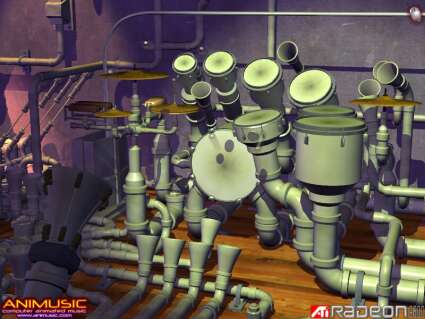Introducing ATi's New Middle Class: The Radeon 9600 PRO
Conclusion
Newer is not automatically synonymous with better, as this review shows. From ATi's perspective, the Radeon 9600 PRO is a success, as it is able to beat the FX 5600 Ultra in the majority of the tests. At the same time, it costs less to produce than the older 9500 PRO model. From the consumer's perspective, the newcomer is a step backwards, though, considering the better overall performance of the "old" 9500 PRO. The performance gap between the generations becomes especially apparent when FSAA and/ or anisotropic filtering is used. Since ATi's main concern is selling cards and making a profit, their step, backwards or not, is understandable.
Compared to the FX 5600 Ultra, the 9600 PRO seems the better choice. For the most part, it offers higher performance and also takes the lead in image quality, thanks to excellent FSAA and anisotropic filtering. The FX 5600 Ultra also seems to have trouble with some modern games like Aquanox 2 (with DX 9 shaders) and Splinter Cell. The results of the 3DMark 2003 subtests were also disappointing. Then again, the possibility remains that NVIDIA will be able to remedy this with a newer driver revision.
Despite its good performance, the gap between the 9600 PRO and the high-end cards remains huge, as the direct comparison with the 9700 PRO shows, not to mention the 9800 PRO. The FX 5600 Ultra suffers from the same problem. On the other hand, this should make high-end buyers happy, since they are really getting premium performance for the premium they're paying. It `s been a while since twice the price could be equated with twice the performance, but here it holds true, at least where FSAA and anisotropic filtering are concerned.
If you don't need the very best in image quality enhancements, can do without DirectX 9 and are happy with 2x FSAA, you'll be glad to hear that there's a very affordable card out there for you - the GeForce 4 Ti 4200. Despite its age, this card still offers remarkable performance compared to current mid-range cards.
The new middle-class cards from NVIDIA and ATi also show us an interesting development: the new, highly praised features like DirectX 9, etc. have one major drawback - they require a lot of circuitry and, consequently, lots of transistors. Less expensive versions based on toned-down high-end chips will inevitably have to be pared down drastically to reduce the transistor count, thereby increasing chip yield and reducing manufacturing cost. Obviously, this will just as inevitably mean reduced performance. In the past, however, most chips of a product line differed only in clock speed, which was no great surprise, considering their moderate transistor count. A GF4 Ti chip only needed about 63 million transistors. If a card with 70-80 million transistors is supposed to incorporate DX9 features, the manufacturer is going to be forced to cut corners somewhere else. From the chipmakers' perspective, the prime candidates are the transistor-hungry DX9 texture and vertex shader units. The reduction comes at a different price though - fewer vertex and texture shaders also mean lower overall performance, especially in older games.
Get Tom's Hardware's best news and in-depth reviews, straight to your inbox.
